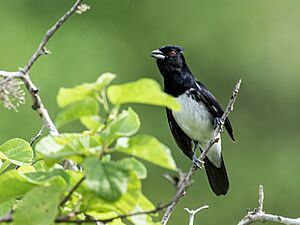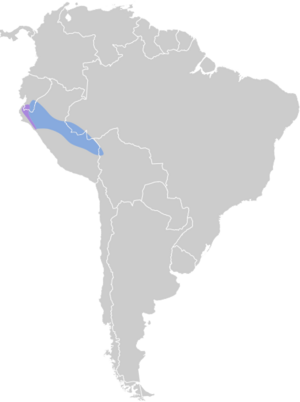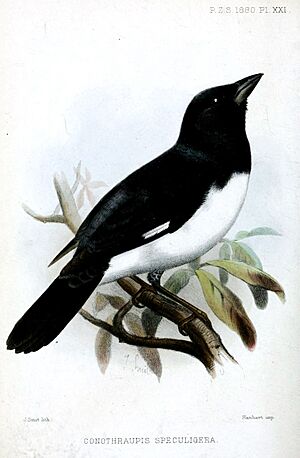Black-and-white tanager facts for kids
Quick facts for kids Black-and-white tanager |
|
|---|---|
 |
|
| Conservation status | |
| Scientific classification | |
 |
The black-and-white tanager (scientific name: Conothraupis speculigera) is a striking bird. It's a type of tanager known for its bold black and white feathers. You can find this bird in the Tumbes region of southwestern Ecuador and northwestern Peru. Sometimes, it travels east to a place called Acre.
This tanager is part of a small bird family. The only other member of its group is the cone-billed tanager.
Contents
What Does the Black-and-white Tanager Look Like?
This bird is about 16 centimeters (6.5 inches) long. It weighs between 23 and 28 grams (about 0.8 to 1 ounce).
Male Tanagers
Male black-and-white tanagers are mostly black. They have a grey area near their tail and white feathers on their belly. A special white patch on their wings is called a "wing-speculum."
They have a longer beak than a bird called the black-and-white seedeater. Unlike their relative, the cone-billed tanager, they don't have black sides or a chalk-white beak.
Female Tanagers
Female tanagers look a bit different. They are more of an olive color. Their belly feathers are yellowish and have faint patterns.
Both male and female tanagers have a reddish eye color. Their beaks are usually greyish.
What Does It Sound Like?
The male black-and-white tanager has a very special song. It's loud and clear, almost like a blackbird's song. It's easy to recognize once you hear it!
Where Do They Live?
These birds live in different kinds of places. You can find them in:
- Scrubs (areas with small bushes)
- Woodlands (areas with trees)
- Forest edges (where forests meet open areas)
They live at different heights, from about 100 meters (330 feet) to 1,800 meters (5,900 feet) above sea level.
How Many Are There?
Black-and-white tanagers are not very common. You might see them alone or in pairs. Sometimes, they gather in larger groups, with up to 50 birds together!
What Do They Eat?
These tanagers enjoy a varied diet. They eat both:
- Insects
- Seeds
Nesting and Eggs
Scientists only fully described the black-and-white tanager's nest in 2006.
The Nest
The nest is quite open and looks a bit messy. It's loosely woven together.
- It's about 6–7 centimeters (2.4–2.8 inches) tall.
- It's about 10–11 centimeters (3.9–4.3 inches) wide on the outside.
- The inside cup, where the eggs sit, is about 6 centimeters (2.4 inches) wide and 4 centimeters (1.6 inches) deep.
The birds usually build their nests in small bushes. They place them at a medium height, about 50–150 centimeters (1.6–4.9 feet) above the ground. They build the nest using small sticks and leaf stems. They line the inside with black, root-like parts of fungi.
The Eggs
A female tanager likely lays 2 or 3 eggs at a time. The eggs are a pale blue color. They have many brown spots spread out evenly. Each egg is about 21 by 15.6 millimeters (0.83 by 0.61 inches) in size.
In the northern parts of their home range, these birds breed during the rainy season, usually around March. After breeding, they tend to spread out to other areas.



